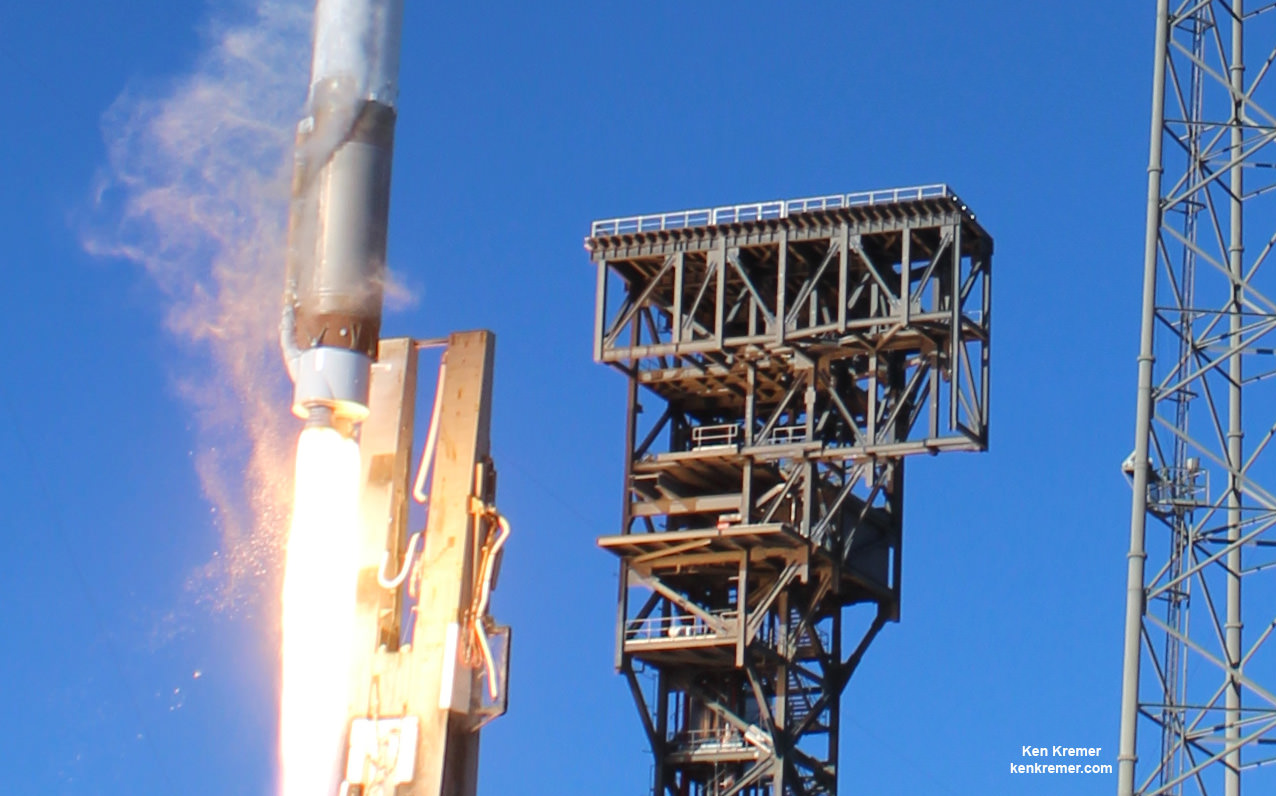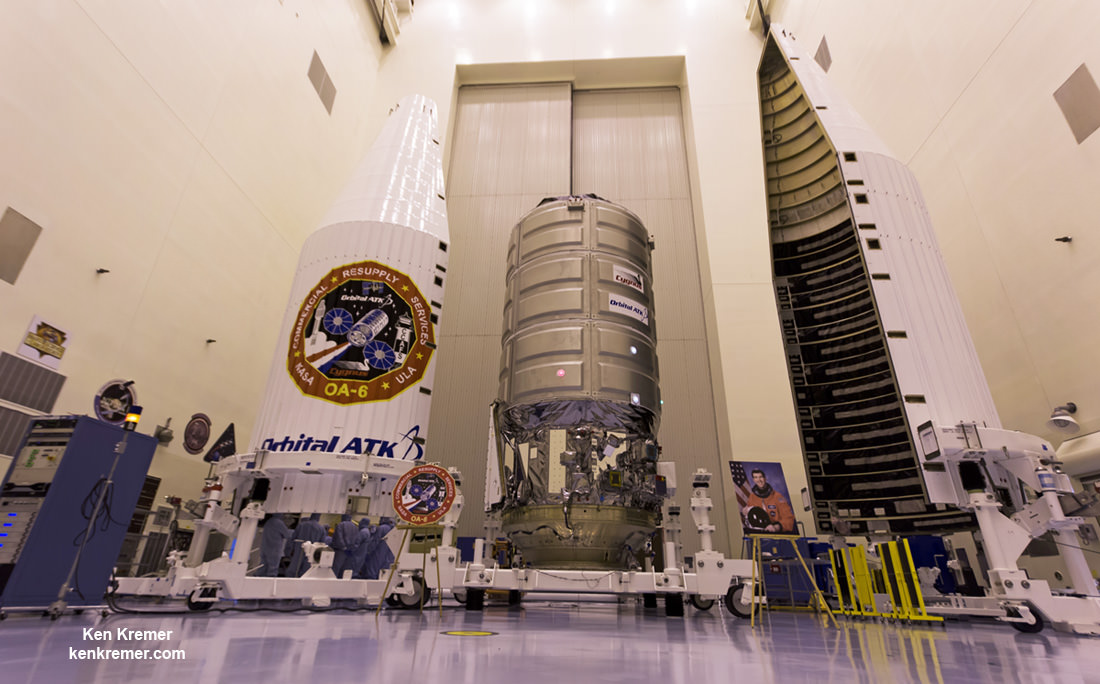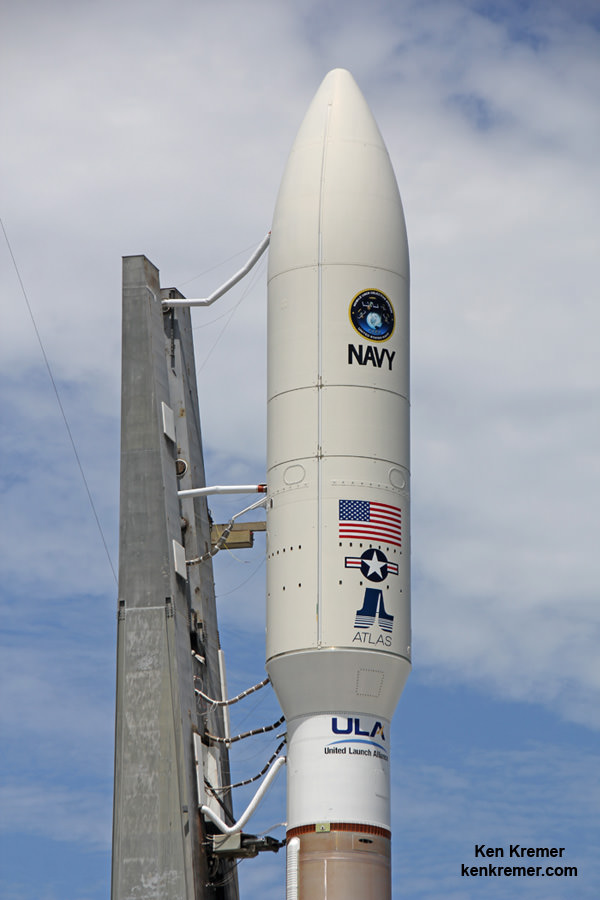
A critical fuel control valve has been faulted for the Atlas V launch anomaly that forced a premature shutdown of the rockets first stage engines during its most recent launch of a Cygnus cargo freighter to the International Space Station (ISS) last month – that nevertheless was successful in delivering the payload to its intended orbit.
Having identified the root cause of the engine shortfall, workers for Atlas rocket builder United Launch Alliance (ULA), have now stacked the booster slated for the next planned liftoff in the processing facility at their Cape Canaveral launch pad, the company announced in a statement Friday.
The Atlas rockets Centaur upper stage fired longer than normal after the first stage anomaly, saving the day by making up for the significant lack of thrust and “delivering Cygnus to a precise orbit, well within the required accuracy,” ULA said.
ULA says it hopes to resume launches of the 20 story tall rocket as soon as this summer, starting with the MUOS-5 communications satellite payload for the U.S. Navy.
Following a painstaking investigation to fully evaluate all the data, the ULA engineering team “determined an anomaly with the RD-180 Mixture Ratio Control Valve (MRCV) assembly caused a reduction in fuel flow during the boost phase of the flight,” the company confirmed in a statement.
The Atlas V first stages are powered by the Russian-made RD AMROSS RD-180 engines. The dual nozzle powerplants have been completely reliable in 62 Atlas launches to date.
The RD-180s are fueled by a mixture of RP-1 kerosene and liquid oxygen stored in the first stage.

The Centaur RL10C-1 second stage powerplant had to make up for a thrust and velocity deficiency resulting from a 6 second shorter than planned firing of the first stage RD-180 engines.
“The Centaur [upper stage] burned for longer than planned,” Lyn Chassagne, ULA spokesperson, told Universe Today.
Indeed Centaur fired for a minute longer than planned to inject Cygnus into its proper orbit.
“The first stage cut-off occurred approximately 6 seconds early, however the Centaur was able to burn an additional approximately 60 seconds longer and achieve mission success, delivering Cygnus to its required orbit,” said ULA.
MUOS-5 was originally supposed to blastoff on May 5. But the liftoff was put on hold soon after the Atlas V launch anomaly experienced during the March 22, 2016 launch of the Orbital ATK Cygnus OA-6 supply ship to the ISS for NASA.
Since then, ULA mounted a thorough investigation to determine the root cause and identify fixes to correct the problem with RD-180 Mixture Ratio Control Valve (MRCV) assembly, while postponing all Atlas V launches.
ULA has inspected, analyzed and tested their entire stockpile of RD-180 engines.
Last Friday, the Atlas V first stage for the MUOS-5 launch was erected inside ULA’s Vertical Integration Facility (VIF) at Space Launch Complex-41 on Cape Canaveral Air Force Station, Florida. The five solid motors have been attached and the Centaur is next.
In this configuration, known as Launch Vehicle on Stand (LVOS) operation, technicians can further inspect and confirm that the RD-180 engines are ready to support a launch.
The two stage Atlas V for MUOS-5 will launch in its most powerful 551 configuration with five solid rocket boosters attached to the first stage, a single engine Aerojet Rocketdyne RL10C-1 Centaur upper stage and a 5-meter-diameter payload fairing.
The RD-180s were supposed to fire for 255.5 seconds, or just over 4 minutes. But instead they shut down prematurely resulting in decreased velocity that had to be supplemented by the Centaur RL10C-1 to get to the intended orbit needed to reach the orbiting outpost.
The liquid oxygen/liquid hydrogen fueled Aerojet Rocketdyne RL10C-1 engine was planned to fire for 818 seconds or about 13.6 minutes. The single engine produces 22,900 lbf of thrust.
The Atlas V first and second stages are preprogrammed to swiftly react to a wide range of anomalous situations to account for the unexpected. The rocket and launch teams conduct countless simulations to react to off nominal situations.
“The Atlas V’s robust system design, software and vehicle margins enabled the successful outcome for this mission,” Chassagne said.
“As with all launches, we will continue to focus on mission success and work to meet our customer’s needs.”
ULA currently sports a year’s long manifest of future Atlas V launches in the pipeline. It includes a wide range of payloads for NASA, US and foreign governments, and military and commercial customers – all of who are depending on ULA maintaining its string of 106 straight launches with a 100% record of success since the company formed in 2006.
The Orbital ATK Cygnus CRS-6 space freighter was loaded with 3513 kg (7700 pounds) of science experiments and hardware, crew supplies, spare parts, gear and station hardware for the orbital laboratory in support of over 250 research experiments being conducted on board by the Expedition 47 and 48 crews.

Cygnus successfully arrived and berthed at the ISS on March 26 as planned.
An exact date for the MUOS-5 launch has yet to be confirmed on the Eastern Range with the US Air Force.
ULA is in the process of coordinating launch dates with customers for their remaining Atlas V launches in 2016.

The 15,000 pound MUOS payload is a next-generation narrowband tactical satellite communications system designed to significantly improve ground communications for U.S. forces on the move.
ULA says they expect minimal impact and foresee completing all launches planned for 2016, including the top priority OSIRIS-REx asteroid mission for NASA which has a specific launch window requirement.

Stay tuned here for Ken’s continuing Earth and planetary science and human spaceflight news.


Interestingly, if the first stage had failed a fraction of a second earlier, the Centaur second stage carrying Cygnus wouldn’t have had enough fuel to make it to the desired orbit… or even orbit at all, depending when MECO occurred.
As it was, after releasing Cygnus, the Centaur second stage attempted do perform an 11-second deorbit burn, which ended only a few seconds after startup because of fuel exhaustion. Pretty crazy how close to the line this launch was!
Interesting note. thanks for sharing.